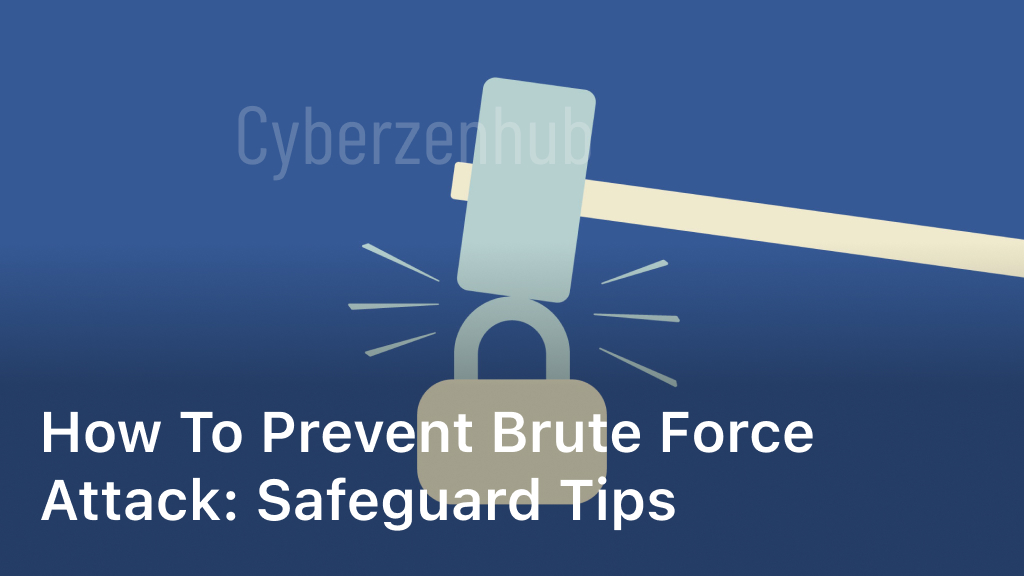Welcome to our comprehensive guide on preventing brute force attacks and safeguarding your digital assets. In this article, we will provide you with effective strategies to protect your web applications from unauthorized access and potential data breaches. By implementing secure login methods and enhancing brute force protection, you can strengthen your overall cybersecurity. Brute force attacks have become a significant threat to online security, targeting websites, applications, and even personal accounts. These attacks involve attackers systematically guessing passwords until they find the correct one, gaining unauthorized access. It is essential to understand the risks associated with such attacks and take proactive measures to mitigate them. In the following sections, we will dive into the details of secure login methods, brute force protection strategies, strengthening web application security, and user education. By employing these safeguard tips, you can ensure the integrity and confidentiality of your sensitive information. Don’t let your web applications fall victim to brute force attacks. Let’s explore the steps you can take to fortify your digital defenses and keep cybercriminals at bay. Understanding Brute Force Attacks Before we dive into prevention strategies, it’s important to understand what a brute force attack is and how it can compromise your web application security. Brute force attacks are malicious attempts to gain unauthorized access to a system or account by systematically trying all possible combinations of passwords or encryption keys until the correct one is found. This method relies on the attacker’s persistence and automated tools to carry out thousands or even millions of login attempts in a short period. Methods Used by Attackers Brute force attacks commonly target login pages, such as those used for email accounts, e-commerce platforms, or content management systems. Attackers can use various techniques, such as: Manual attacks: Attackers manually enter different passwords or keys into login forms, relying on intuition or common patterns to guess the correct one. Wordlist attacks: Attackers use pre-generated lists of commonly used passwords or combinations to systematically try each one until they gain access. Dictionary attacks: Attackers use dictionaries or word databases to try every word or combination in the list as a password, hoping to find a match. Brute force software: Attackers employ automated tools, known as brute force software, to efficiently iterate through all possible combinations of characters, symbols, and numbers. Potential Risks Understanding the potential risks posed by brute force attacks is essential for comprehending the importance of implementing effective prevention measures. These risks include: Unauthorized access: Successful brute force attacks can grant attackers unauthorized access to sensitive data, personal information, or confidential documents. Data breaches: Brute force attacks can lead to data breaches, which can severely impact individuals or organizations, resulting in financial losses, reputational damage, or legal consequences. Account takeovers: By gaining access to user accounts, attackers can hijack email accounts, social media profiles, or financial platforms, posing as the account owner and engaging in malicious activities. Resource consumption: Brute force attacks often put a strain on servers, consuming significant amounts of processing power, memory, or network resources, potentially leading to system failures or slowdowns. Now that we have a solid understanding of what brute force attacks are and the risks they pose, we can explore effective prevention strategies to safeguard your web application security. Secure Login Methods Implementing secure login methods is essential to ensure the protection of your digital assets and prevent brute force attacks. By following best practices for creating strong passwords, utilizing two-factor authentication, and implementing login rate limiting, you can significantly enhance the security of your login process. Strong Password Guidelines Creating strong and complex passwords is an effective way to safeguard your accounts from unauthorized access. Here are some guidelines to consider: Use a combination of uppercase and lowercase letters, numbers, and special characters. Avoid using easily guessable information like your name, birthdate, or simple words. Ensure your password is at least 8-12 characters long. Regularly update your passwords and avoid reusing them across multiple accounts. Two-Factor Authentication Two-factor authentication (2FA) adds an extra layer of security to your login process by requiring two different types of authentication. Typically, this involves something you know (like a password) and something you possess (like a unique code from an authentication app or a fingerprint). By enabling 2FA, even if a malicious actor obtains your password, they would still need the second factor to gain access to your account. Login Rate Limiting Login rate limiting is a technique to prevent brute force attacks by restricting the number of login attempts within a specified timeframe. By implementing rate limits, you can deter attackers from guessing passwords through repeated login attempts. This helps to protect against automated scripts or bots that attempt to gain unauthorized access by trying numerous combinations of usernames and passwords. By following these secure login methods, you can significantly reduce the risk of falling victim to brute force attacks. Remember to consistently update and strengthen your password, enable two-factor authentication, and implement login rate limiting to ensure the security of your accounts and sensitive information. Brute Force Protection Strategies In addition to implementing secure login methods, there are other effective strategies you can employ to protect against brute force attacks. Two commonly used techniques are IP blocking strategies and captcha implementation. IP Blocking Strategies IP blocking is a proactive approach that involves preventing access to your website or application from specific IP addresses or IP ranges. By blocking suspicious or known malicious IP addresses, you can significantly reduce the risk of brute force attacks. There are several IP blocking strategies you can implement: Blacklisting: Maintain a blacklist of IP addresses associated with known attackers. This can be done manually or through the use of threat intelligence services. Whitelisting: Restrict access to your website or application to only trusted IP addresses, effectively blocking all others. Rate Limiting: Implement rate limiting policies that restrict the number of login attempts allowed within a certain timeframe from a specific IP address. This helps prevent brute force attacks by slowing down the rate at





